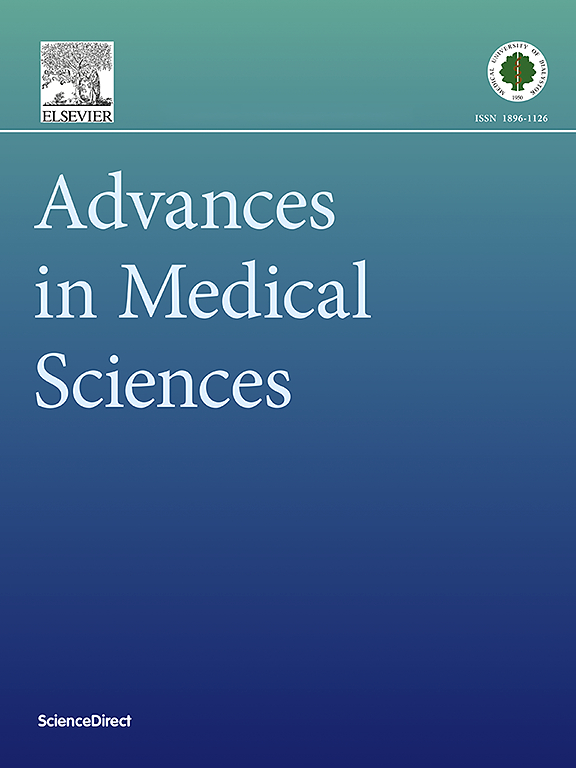加强利尿剂治疗肺动脉高压-血流动力学和功能改变的回顾性评估。
IF 2.6
4区 医学
Q3 MEDICINE, RESEARCH & EXPERIMENTAL
引用次数: 0
摘要
目的:利尿剂是治疗肺动脉高压(PH)容量超载的一线药物。它们对血流动力学和功能参数的影响尚未研究。本研究分析强化利尿剂治疗对患者病情恶化的影响。方法:回顾性分析38例患者,分为1组(n=24,等效利尿剂剂量不变或不使用利尿剂治疗)和2组(n=14,等效利尿剂剂量增加)。基线和6个月后的测量包括超声心动图参数、6分钟步行测试距离(6MWTd)和脑利钠肽n端原激素(NT-proBNP)。结果:在研究参数的初步评估中,与1组相比,2组下腔静脉直径(IVCd)和右心室舒张内径(RVIDd)显著增加,右心房面积(RAA)增加,三尖瓣下环面收缩偏移(TAPSE)增加,NT-proBNP值增加。在6个月的随访期间,1组IVCd、收缩期肺动脉压(sPAP)显著升高,TAPSE/sPAP比值显著降低,平均肺动脉压(mPAP)和6MWTd值有升高趋势。另一方面,组2没有明显恶化,这反映了利尿剂强化治疗的稳定作用。结论:在6个月的时间里,强化利尿剂治疗PH和液体超载患者可以稳定运动能力,防止心功能恶化。本文章由计算机程序翻译,如有差异,请以英文原文为准。
Intensification of diuretic therapy in pulmonary hypertension – a retrospective evaluation of hemodynamic and functional changes
Purpose
Diuretics are first-line medication in the management of volume overload in pulmonary hypertension (PH). Their impact on the hemodynamic and functional parameters has not been studied. This study analyzes the impact of intensified diuretic therapy on patients deterioration.
Methods
The retrospective analysis included 38 patients who were divided into Group 1 (n = 24, no change in the equivalent diuretic dose or treatment without diuretics) and Group 2 (n = 14, increase in the equivalent diuretic dose). Measurements at baseline and after 6 months included echocardiographic parameters, 6-min walk test distance (6MWTd), and N-terminal prohormone of brain natriuretic peptide (NT-proBNP).
Results
In the initial assessment of the studied parameters, Group 2 had a significantly greater inferior vena cava diameter (IVCd) and right ventricle internal diameter in diastole (RVIDd), trends towards greater right atrium area (RAA), lower tricuspid annular plane systolic excursion (TAPSE), and greater NT-proBNP values compared to Group 1. Over the 6-month follow-up period, Group 1 had a significant increase in IVCd, systolic pulmonary artery pressure (sPAP), significant decrease in TAPSE/sPAP ratio and trends towards increased mean pulmonary artery pressure (mPAP) and 6MWTd values. Group 2, on the other hand, had no significant worsening, which reflects a stabilizing impact of intensified diuretic therapy.
Conclusion
Intensified diuretic therapy in patients with PH and fluid overload appears to stabilize exercise capacity and prevent deterioration of cardiac function over a 6-month period.
求助全文
通过发布文献求助,成功后即可免费获取论文全文。
去求助
来源期刊

Advances in medical sciences
医学-医学:研究与实验
CiteScore
5.00
自引率
0.00%
发文量
53
审稿时长
25 days
期刊介绍:
Advances in Medical Sciences is an international, peer-reviewed journal that welcomes original research articles and reviews on current advances in life sciences, preclinical and clinical medicine, and related disciplines.
The Journal’s primary aim is to make every effort to contribute to progress in medical sciences. The strive is to bridge laboratory and clinical settings with cutting edge research findings and new developments.
Advances in Medical Sciences publishes articles which bring novel insights into diagnostic and molecular imaging, offering essential prior knowledge for diagnosis and treatment indispensable in all areas of medical sciences. It also publishes articles on pathological sciences giving foundation knowledge on the overall study of human diseases. Through its publications Advances in Medical Sciences also stresses the importance of pharmaceutical sciences as a rapidly and ever expanding area of research on drug design, development, action and evaluation contributing significantly to a variety of scientific disciplines.
The journal welcomes submissions from the following disciplines:
General and internal medicine,
Cancer research,
Genetics,
Endocrinology,
Gastroenterology,
Cardiology and Cardiovascular Medicine,
Immunology and Allergy,
Pathology and Forensic Medicine,
Cell and molecular Biology,
Haematology,
Biochemistry,
Clinical and Experimental Pathology.
 求助内容:
求助内容: 应助结果提醒方式:
应助结果提醒方式:


